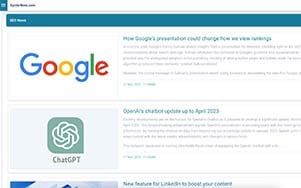What is Google Ads optimization, and why is it important?
Google Ads optimization involves making strategic adjustments to campaigns to improve their performance and achieve better results. It's important because:
1. Maximized ROI: Optimization helps ensure that your ad spend is used efficiently to generate the highest possible return on investment (ROI).
2. Improved Relevance: Optimized ads are more relevant to your target audience, leading to higher click-through rates (CTRs) and conversion rates.
3. Better User Experience: Optimized campaigns provide a smoother and more relevant experience for users, resulting in increased engagement and satisfaction.
Effective Google Ads Management Techniques
Effective management techniques are crucial for running a successful Google Ads campaign. One important technique is closely monitoring and analyzing the performance of your ads. By regularly reviewing key metrics such as click-through rate (CTR), conversion rate, and return on ad spend (ROAS), you can identify areas for improvement and make data-driven decisions to optimize your campaign.
Another key management technique is optimizing your ad targeting. By narrowing down your target audience based on demographics, interests, and behaviors, you can ensure that your ads are shown to the most relevant users, increasing the likelihood of conversions.
In conclusion, effective management techniques are crucial for running a successful Google Ads campaign. By closely monitoring performance, optimizing ad targeting, managing budget effectively, and regularly testing and optimizing ads, you can achieve maximum results and drive the success of your campaign.
Understanding Google Ads Metrics
Understanding key metrics is essential for evaluating the performance of your Google Ads campaign. One important metric to consider is the click-through rate (CTR), which measures the percentage of users who clicked on your ad after seeing it. A high CTR indicates that your ad is engaging and relevant to your target audience.
Conversion rate is another crucial metric to track. It measures the percentage of users who completed a desired action, such as making a purchase or filling out a form, after clicking on your ad. A high conversion rate indicates that your ads are effectively driving conversions.
Return on ad spend (ROAS) is a metric that measures the profitability of your ads. It calculates the revenue generated from your ads compared to the amount spent on them. A high ROAS indicates that your ads are generating a positive return on investment.
Keyword Research and Selection
Keyword research and selection are crucial steps in optimizing your Google Ads campaign. By conducting thorough research, you can identify the most relevant and high-performing keywords for your ads.
Start by brainstorming a list of potential keywords that are relevant to your products or services. Use keyword research tools, such as Google Keyword Planner, to expand your list and discover new keyword ideas. Consider the search volume, competition, and relevance of each keyword when making your selection.
It's also important to consider the intent behind each keyword. Are users searching for information, looking to make a purchase, or seeking a specific service? By understanding the intent, you can align your ads and landing pages to better meet the needs of your target audience.
Once you have selected your keywords, organize them into relevant ad groups to ensure that your ads are closely aligned with the search terms. This will improve the relevance and quality of your ads, resulting in higher click-through rates and conversions.
Ad Copy and Creative Optimization
Ad copy and creative optimization are essential for capturing the attention of your target audience and maximizing the performance of your Google Ads campaign.
Start by crafting compelling and engaging ad copy that clearly communicates the value proposition of your products or services. Use persuasive language, highlight unique selling points, and include a strong call-to-action to encourage users to click on your ads.
Additionally, optimize the creative elements of your ads, such as images, videos, or interactive elements. Use visually appealing and high-quality visuals that are relevant to your products or services. Experiment with different formats and designs to find what resonates best with your target audience.
It's also important to ensure that your ad copy and creative elements are in line with your landing page. Consistency between your ads and landing pages enhances the user experience and increases the likelihood of conversions.
Regularly test different variations of your ad copy and creative elements to identify what performs best. Analyze the results and make data-driven decisions to optimize your ads for better performance.
How does optimizing a Google Ads campaign impact ad rankings and overall performance?
Optimizing a Google Ads campaign can positively impact ad rankings and overall performance in several ways:
1. Improved Ad Relevance: Optimized campaigns are more relevant to users' search queries and intent, leading to higher ad quality scores and better ad rankings in the ad auction.
2. Higher CTRs: Optimization techniques such as refining ad copy, testing different ad formats, and targeting specific audiences can lead to higher CTRs, improving ad rankings and visibility.
3. Better User Experience: Optimized campaigns provide users with more relevant and engaging ads, resulting in higher engagement metrics, longer session durations, and lower bounce rates.
4. Increased Conversions: By targeting the right keywords and audiences and providing a compelling offer or call to action, optimized campaigns can drive more conversions and achieve better overall campaign performance.
In summary, optimizing your Google Ads campaign is essential for maximizing ROI, improving ad relevance, and driving better overall performance. By implementing effective optimization strategies and continually monitoring and refining your campaigns, you can achieve higher CTRs, conversion rates, and ROAS, ultimately driving better results for your business.










